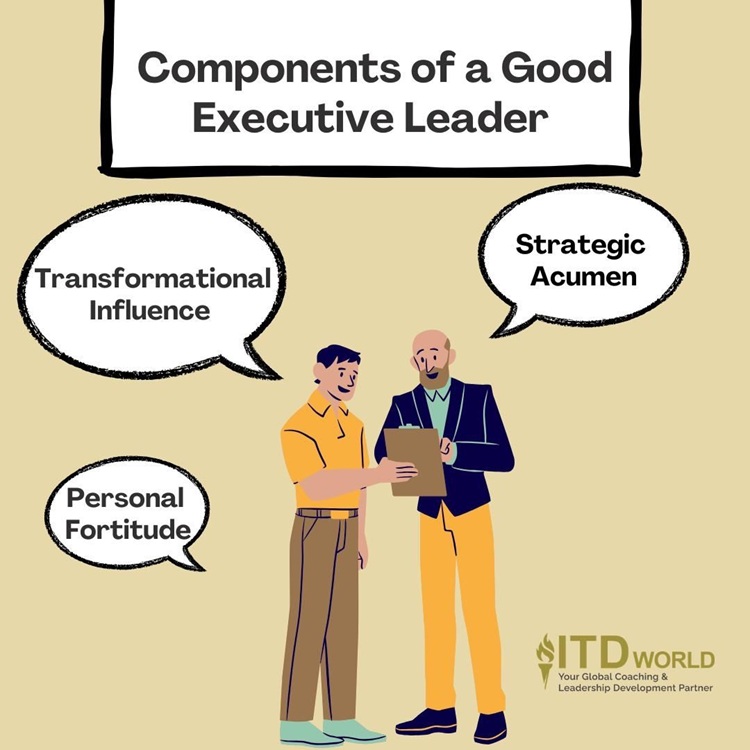In today’s landscape of constant disruption and fierce competition, what truly separates thriving organizations from those that merely survive? The answer isn’t just a superior product or a technological edge; it’s the caliber of their executive leadership. Effective executives do more than manage – they shape the future by providing the vision, strategy, and resilience necessary to navigate uncertainty and inspire enterprise-wide performance. Below, we will explore the essence of true executive leadership, from its critical impact on business success and the core competencies required, to the strategic imperative of investing in its development to secure a competitive advantage for years to come.
|
Author: Jonathan M. Pham |
Highlights
- Executive leadership is a strategic discipline focused on building the organization’s future by defining its vision, instilling core values, and aligning resources to achieve strategic victories. It is crucial for navigating today’s complex business landscape, driving strategy, and cultivating high-performance culture.
- Effective executive leaders possess a sophisticated blend of strategic acumen (visionary foresight, business, and financial understanding), transformational influence (executive presence, powerful communication, and change leadership), and personal fortitude (resilience, adaptability, decisiveness, and a strong personal brand).
- Investing in executive leadership training is key to enhancing strategic decision-making, organizational agility, succession planning, employee engagement, and ultimately, bottom-line results.
What is Executive Leadership?
While management is typically focused on efficiently running the systems of today, executive leadership is the discipline of building the organization of tomorrow. It is a strategic function concerned not with climbing the ladder, but with seeing the entire landscape from the top.
At its core, executive leadership can be understood through three fundamental pillars:
- Vision: Defining and articulating a clear, compelling, and ambitious future for the organization. It addresses the fundamental question, “Where are we going?”
- Values: Instilling and embodying the core principles and ethical standards that guide every decision and action. It establishes a strong cultural foundation by answering, “Who are we and what do we stand for?”
- Victories: Aligning the entire enterprise – its people, capital, and resources – towards achieving the specific strategic wins that will turn the vision into reality.

It is crucial to distinguish executive leadership from senior leadership/ management. While the two terms are often used interchangeably, their scope and focus are fundamentally different. This distinction is vital for clarifying roles, managing expectations, and designing effective development pathways.
| Aspect | Senior leadership |
Executive leadership
|
| Focus | Functional/operational excellence |
Enterprise-wide strategy & viability
|
| Time horizon | Short-term (quarters to 1-2 years) | Long-term (3-10+ years) |
| Responsibility | Leading a department or function (e.g., Sales, Ops) | Leading the entire organization or a major business unit |
| Primary goal | Hitting targets, optimizing processes | Shaping the market, ensuring long-term success |
Executive leadership vs senior leadership
Given the above-mentioned scope, executive leadership is practiced at the highest echelons of an organization. It is the domain of the C-Suite – including the Chief Executive Officer, Chief Operating Officer, and other chief officers – as well as Executive Vice Presidents and other senior figures who hold ultimate responsibility for the performance and strategic direction of the entire enterprise.
All in all, it is less about a specific title and more about the ultimate scope of one’s accountability to the organization as a whole.
The Importance of Executive Leadership
In today’s volatile business environment, the quality of leaders at the top is the ultimate competitive differentiator, creating a ripple effect that touches every aspect of the business, from financial returns to the daily experience of every employee.
- Steering the ship: Driving strategy and performance
A clear and well-communicated strategy is the bedrock of any successful enterprise. Executives are responsible for cultivating such clarity. When leadership fails to set a clear direction, the entire organization drifts. Conversely, when leaders are effective, the results are tangible.
According to research by McKinsey, transformations are far more likely to succeed when leaders articulate a compelling vision. Their findings show that when frontline staff feel a sense of ownership for the change – a feeling directly fostered by leadership communication – the success rate of transformation initiatives jumps to 70%. In other words, executive strategy is not just a document; it’s a vital, active force for visualizing business goals.
- Building the engine: Shaping a high-performance culture
Culture eats strategy for breakfast.
Peter Drucker
While strategy sets the course, it is the organization’s culture that provides the fuel. In fact, a brilliant plan will fail if the underlying culture is unhealthy – and executives serve as the primary architects. Their actions, priorities, and behaviours signal what is truly valued.
Research from Gallup has consistently shown that managers account for up to 70% of the variance in team engagement. Executive leaders set the tone for every one of those managers. When the executive team fosters a culture of recognition, trust, and purpose, engagement soars.
According to a recent SHRM report, 83% of employees in excellent work cultures are deeply motivated, compared to just 45% in poor cultures, highlighting the immense discretionary effort that strong leadership unlocks.
- Navigating storms: Leading through change and crisis
The true test of leadership often comes during periods of significant disruption. In these moments, the executive team’s ability to provide stability, direction, and confidence is paramount. Poor leadership during a transformation is a primary reason why, as McKinsey notes, an estimated 70% of change programs fail to achieve their goals.
Effective executive leadership turns these odds around by being visibly committed, communicating transparently, and promoting resilience throughout the organization.
- The multiplier effect of an aligned team
Last but not least, the impact of executive leadership is multiplied when it operates as a cohesive and aligned team. A group of high-performing individuals is not enough; they must be unified in purpose and strategy.
A study featured in the Harvard Business Review found that companies with high levels of trust – a key outcome of an aligned leadership team – boast 50% higher productivity. When an executive team is aligned, decisions are made faster, resources are allocated more effectively, and the organization moves with a unified purpose, creating an environment where success is not just possible, but probable.

What Makes a Good Executive Leader?
The profound impact described previously does not happen by chance. It is the direct result of a distinct set of competencies that separate effective executives from the rest. These qualities are not merely innate traits – but a sophisticated blend of strategic thinking, interpersonal influence, and deep personal character.
Strategic acumen (the “Thinking”)
As the intellectual foundation of executive leadership, strategic acument refers to the ability to rise above the daily operational noise and view the organization and its environment from a high-altitude perspective.
- Visionary foresight
This goes beyond simple planning. It is the ability to identify patterns, connect disparate trends, and see the future of the industry before it arrives.
For instance, consider a retail executive who, years before it became mainstream, recognized the combined rise of conscious consumerism and the circular economy. Their foresight allowed them to pivot the company’s long-term strategy towards sustainable sourcing and resale programs, capturing a new market and building immense brand value while competitors were still focused on traditional models.
- Business & financial acumen
An executive must fluently speak the language of the business. In other words, they need to deeply understand the drivers of revenue and profitability, be able to interpret complex financial statements, and confidently allocate capital to initiatives that deliver the highest strategic return.
Transformational influence (the “Leading”)
An executive’s ideas have value only if they can inspire others to act on them. As such, they need a sophisticated ability to engage, align, and mobilize people across the entire enterprise.
This is the earned authority that commands respect and inspires confidence. It is not about charisma but about composure, credibility, and gravitas under pressure.
An executive with presence can walk into a tense town hall meeting following a disappointing quarter, listen intently to difficult questions, and respond with a calm confidence that reassures stakeholders and reinforces belief in the long-term strategy.
Read more: Stakeholder Management – A Leader’s Engagement Playbook
- Powerful communication & storytelling
Executives must translate complex strategies into simple, compelling narratives that resonate with diverse audiences, from the boardroom to the front lines. They don’t just present data; they weave a story that explains where the organization is going, why it matters, and how every individual plays a vital role.
- Change leadership
This is the skill of guiding the organization and its people through the discomfort of transformation. It involves building coalitions, managing resistance with empathy, and relentlessly communicating the “why” behind the change to create momentum and buy-in.
Read more: Change Management – How to Champion It
Personal fortitude (the “Being”)
This is the core of the leader – the personal character and resilience that enable them to withstand the immense pressures of the role and act with integrity.
- Resilience & adaptability
The executive journey is fraught with setbacks. Resilience is the capacity to absorb these challenges, learn from failure, and bounce back with renewed focus. Adaptable leaders treat missteps not as defeats, but as data to refine their approach.
- Decisiveness in ambiguity
Executives rarely have the luxury of complete information. They must have the courage to make high-stakes decisions in the face of uncertainty.
Imagine a technology leader deciding whether to commit billions to developing a proprietary AI platform – a huge risk with a potentially massive payoff – or to continue investing in a safer, established product line. A decisive leader gathers the best available data, weighs the strategic trade-offs, and makes a committed choice, knowing that indecision is often the riskiest path of all.
- A strong personal brand
This refers to one’s reputation for integrity, expertise, and consistency – in other words, what they are known for. A leader with a strong personal brand built on trust and reliability can rally support and earn the benefit of the doubt, as their character and track record speak for them.

The Case for Investing in Executive Leadership Training
The sophisticated blend of strategic acumen, influence, and personal fortitude required at the top is rarely acquired through experience alone; as such, relying on chance to forge your next generation of leaders is a high-risk strategy. Instead, organizations that thrive do so by intentionally cultivating this capability through strategic investment in executive development.
Why great managers don’t automatically become great executives
A common mistake in succession planning is the “promotion paradox”: an organization promotes its best operational manager into an executive role, only to see them struggle. The reason is that the skills that create a world-class manager are fundamentally different from those required of a world-class executive. The transition represents a seismic shift in responsibility:
- From managing processes to navigating ambiguity.
- From leading a function to leading the entire enterprise.
- From delivering results to building the culture that contributes to results.
- From managing doers to leading other leaders.
Such a leap requires a deliberate rewiring of one’s mindset and skillset. Without a structured development process, you are not setting your emerging leaders up for success – you are setting them up for burnout!
The tangible ROI of executive development
Investing in leadership development is not a cost center; it is a direct investment in the organization’s future performance and resilience. The returns are tangible, measurable, and compound over time:
- Enhanced strategic decision-making: Trained executives are better equipped to analyze complex market dynamics, identify opportunities, and make bold, informed decisions that drive sustainable growth.
- Increased organizational agility: Developed leaders are more adept at leading through change, fostering innovation, and creating an agile culture that can pivot quickly in response to market disruptions.
- A stronger succession pipeline: A formal development program is the most effective way to identify and prepare high-potential individuals, ensuring you have a bench of ready, capable leaders to step into critical roles and mitigate skill gaps.
- Elevated employee engagement & retention: The quality of executive leadership directly impacts morale and culture. Effective leaders create environments where top talent wants to stay and contribute their best work.
- Improved bottom-line results: Ultimately, all of these benefits – smarter strategy, greater agility, and a more engaged workforce – translate into superior financial performance and increased shareholder value.
Read more: Employee Engagement in the Digital Age – A Holistic Guide
Key methodologies for effective executive training
Leadership development cannot be a one-size-fits-all, classroom-only experience. To be effective, it must be tailored, applied, and multi-faceted. The most successful approaches blend various methodologies to create a comprehensive learning journey:
- One-on-one coaching and mentoring: Provides a confidential, personalized space for leaders to tackle their most pressing challenges and realize their unique potential.
- Strategic action learning: Moves beyond theory by having leaders apply new frameworks to solve real, high-stakes business problems, delivering an immediate return to the organization.
- Peer advisory groups: Establishes a powerful network of trusted equals who can share experiences, offer candid feedback, and provide mutual support.
- Formal learning & certifications: Builds a solid foundation of proven leadership models and strategic frameworks from world-class sources.
Read more: Coaching vs Mentoring – Define the Differences

Executive Leadership Quotes
Before you are a leader, success is all about growing yourself. When you become a leader, success is all about growing others.
Jack Welch
Leadership is unlocking people’s potential to become better.
Bill Bradley
A leader is best when people barely know he exists, when his work is done, his aim fulfilled, they will say: we did it ourselves.
Lao Tzu
The first responsibility of a leader is to define reality. The last is to say thank you. In between, the leader is a servant.
Max DePree
Leadership is the capacity to translate vision into reality.
Warren Bennis
Executive Leadership Books
- The 21 Irrefutable Laws of Leadership by John Maxwell – A practical guide to leadership principles that enable leaders grow and empower others.
- Good to Great: Why Some Companies Make the Leap… and Others Don’t by Jim Collins – A deep dive into what makes companies truly great and sustainable.
- Start with Why by Simon Sinek – Explores how purpose-driven leadership inspires action and loyalty.
- The First 90 Days by Michael Watkins – A roadmap for leaders transitioning into new roles, helping them secure early wins.
- The Five Dysfunctions of a Team by Patrick Lencioni – A leadership fable that uncovers common team challenges and how to overcome them.

Discover ITD World’s Executive Leadership Development Programs
Building the high-impact executive leadership your organization needs requires a deliberate, proven, and expert approach. At ITD World, we understand that developing world-class leaders is a journey, not a single event. Our suite of globally recognized programs is designed to address the specific challenges and opportunities leaders face at critical points in their careers, leveraging the powerful, blended methodologies that drive real transformation.
- For building a world-class coaching & mentoring culture
Great executives are also great coaches. To foster this capability at scale, we offer our premier certification programs. The Certified Coaching & Mentoring Professional (CCMP) and the advanced Certified Chief Master Coach (CCMC) are designed to equip your leaders and HR professionals with the elite skills needed to unlock potential, drive performance, and cultivate a culture of empowerment and growth from within.
Additionally, we also offer specialized executive coaching solutions to those who are in need of them.
- For comprehensive executive leadership development
Our Global Elite Senior Leadership Development Program (SLDP) is a holistic journey designed to sharpen the strategic acumen, transformational influence, and personal fortitude detailed earlier. Participants emerge with the enterprise-wide perspective and leadership presence required to navigate complexity and shape the future of your organization.
- For enabling strategic HR and change leadership
Your HR function should be a key driver of your leadership strategy. We empower them to step into this role with solutions such as the Certified Human Resource Business Partner (CHRBP) program – designed to elevate HR leaders from functional managers to true strategic partners. Graduates are equipped to co-create and execute the talent, culture, and change management initiatives that are essential for supporting and sustaining excellence.
- Customized in-house solutions
We recognize that every organization has a unique culture and faces specific challenges. Beyond our public programs, we partner directly with clients to design and deliver fully customized in-house solutions, qualifications, and certifications. This tailored approach ensures that your investment is perfectly aligned with your most critical strategic objectives.
The path to securing your organization’s future runs directly through the development of its leaders. Investing in their growth is the most powerful lever you have to build a resilient, agile, and successful enterprise.
Your partner in executive excellence: The ITD World’s approach
Ready to build the leaders who will define your tomorrow? Contact ITD World today to discover the right development path for your organization!
Other resources you might be interested in:
- 5 Executive Coaching Goals Leaders Need for Success
- Leadership Values: 10 Qualities for Exceptional Results
- Leadership Feedback: Key to Changing for the Better
- 7 Leadership Mistakes to Avoid: From Failure to Success
- Talent Development Playbook: Building Your Future Workforce

